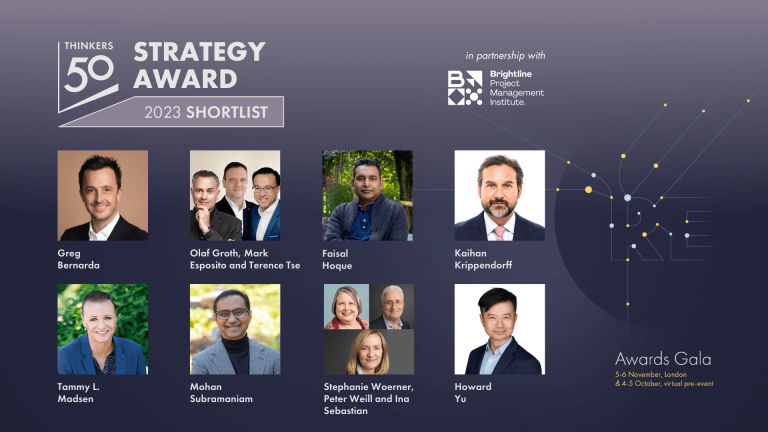

 Think again about competitive advantage. The arguments about whether competitive advantage is sustainable or even possible is a passionate one. Roger Martin provides practical advice: “I think a lot of the debate is not all that helpful. It is obvious that competitive advantage exists in the world. It is also obvious that competitive advantage doesn’t last forever. Nothing lasts forever. And if you’re trying to say that there is no such thing as competitive advantage, think of all the high performing, normally profitable companies, who’ve maintained that for years and years and years. It’s hard to say that’s not competitive advantage.
Think again about competitive advantage. The arguments about whether competitive advantage is sustainable or even possible is a passionate one. Roger Martin provides practical advice: “I think a lot of the debate is not all that helpful. It is obvious that competitive advantage exists in the world. It is also obvious that competitive advantage doesn’t last forever. Nothing lasts forever. And if you’re trying to say that there is no such thing as competitive advantage, think of all the high performing, normally profitable companies, who’ve maintained that for years and years and years. It’s hard to say that’s not competitive advantage.
“So the question, to me, becomes, is there a thinking process that can help managers make decisions that produce advantage, to create high amounts of value for customers that enables you to make an attractive return, and opens up other possibilities to keep on renewing that? That’s the fundamental question I ask. My view is, yes, there’s a process of thinking that’s more likely to get you answers. There’s an intelligent process for identifying where to play, how to win, and if we make choices of that sort we will position ourselves in a way that gives us the opportunity to keep modifying that and enhancing it ahead of other people, so that we do have an advantage over a sustained period of time. It’s not the same advantage, right; it actually could be different sorts of advantages over time. So if you look over a 50-year period, it may actually be a whole bunch of different sorts of advantages. But it’s because we have a practice of asking a set of questions that keeps us ahead of the game, rather than simply reacting to changes.
“The world isn’t static. Strategy isn’t static, but that doesn’t mean there isn’t a way of thinking about the fundamental questions in a way that keeps you ahead of the competition.”
Tune In: “Despite the roar of voices wanting to equate strategy with ambition, leadership, ‘vision’, planning, or the economic logic of competition, strategy is none of these. The core of strategy work is always the same: discovering the critical factors in a situation and designing a way of co-ordinating and focusing actions to deal with those factors,” says Richard Rumelt.
Ask questions. You tune-in by asking questions. Simple. “We need to ask better questions and generate fewer hypotheses — to allow ourselves to be pulled by real-life concerns rather than pushed by reified concepts. We need better practice, not neater theory,” advises Henry Mintzberg. “So we must concern ourselves with process and content, statics and dynamics, constraint and inspiration, the cognitive and the collective, the planned and the learned, the economic and the political. In other words, we must give more attention to the entire elephant – to strategy formation as a whole. We may never see it fully, but we can certainly see it better.”
Understand the broader context: David Bach of Yale School of Management observes: “Companies are very comfortable with the idea that you can shape customers’ expectations, erect entry barriers, change your relationship with suppliers, and mold your market environment. They are not so comfortable with the idea of trying to mold their social and political environment.”
Think of barriers to exit not barriers to entry. In the past the strategic talk was of barriers to entry, but now we’ve got to start thinking in terms of barriers to exit. “I argue that one of the things firms are going to do differently is they’re going to be much more careful about sinking lots of assets and lots of investment into specifically competitive places because if you need to move fast you don’t want a lot of fixed assets,” says Rita McGrath. “You want to be able to use assets that are fairly fungible. It’s access to assets rather than ownership of assets, which we’re going to see as the defining issue in how you expend resources going forward.”
Look to create new markets. Mining existing markets is necessary but increasingly not sufficient to secure future growth. “The challenge is to create new demand, what we call market space,” says Blue Ocean Strategy co-author Renee Mauborgne. “New market space is about creating a company’s future. Companies can continue to mine their wealth from an existing market space — that’s maintenance. They can concentrate on market share. But there is something more — the act of creation. Creating new market space will become increasingly vital.
“Creating new market space provides growth. There are two paths to growth. One is the mergers and acquisition path, which often leads to growth but rarely leads to profitable growth. The other is organic growth by creating new businesses. While this path is profitable and necessary, in markets where supply exceeds demand, companies are often hesitant because they don’t have a path forward to believe that they could succeed in changing things. They need a bridge to get there. Hopefully, some of the ideas and analytics we have been developing will help companies in building that bridge.”
Involve as many people as possible. The C-suite doesn’t have a monopoly on strategic wisdom – or any other kind of wisdom. People throughout an organization need to be emboldened to think and care about strategy. Says Roger Martin: “Where ever you are in the organization you have to make strategy choices too. If everybody felt that they have to make strategy choices I think corporations would work a lot better than saying we make the choices up above, and you people down there execute. It’s not the way the world actually works, and it’s not a helpful kind of conception of the corporation.”
Know yourself. Leaders are encouraged to really understand their inner ambitions and motivations. Much the same applies to organizations. Success comes from within. Chris Zook of Bain told us that the consistent revelation of his research and case studies is that the main barrier to companies finding their next wave of growth is themselves. “The answer is internal,” he advised. “Only 15 percent of the variation in performance among companies is related to choice of market, and 85 percent is related to how those businesses compete against others around them. And when we actually look at the main issues and barriers that companies have in that regard, we find more of them tend to be internal than external. Businesses can tend to be their own enemies, and self-awareness, at the end of the day, is probably at the epicenter of a lot of the great success stories and great failure stories in business.” Look inside.
This was originally published in What we mean when we talk about strategy by Stuart Crainer and Des Dearlove (Infinite Ideas, 2016).

Thinkers50 Limited
The Studio
Highfield Lane
Wargrave RG10 8PZ
United Kingdom

Thinkers50 Limited
The Studio
Highfield Lane
Wargrave RG10 8PZ
United Kingdom

| Cookie | Duration | Description |
|---|---|---|
| LANG | 9 hours | Linkedin set this cookie to set user's preferred language. |
| nsid | session | This cookie is set by the provider PayPal to enable the PayPal payment service in the website. |
| sp_landing | 1 day | The sp_landing is set by Spotify to implement audio content from Spotify on the website and also registers information on user interaction related to the audio content. |
| sp_t | 1 year | The sp_t cookie is set by Spotify to implement audio content from Spotify on the website and also registers information on user interaction related to the audio content. |
| tsrce | 3 days | PayPal sets this cookie to enable the PayPal payment service in the website. |
| x-pp-s | session | PayPal sets this cookie to process payments on the site. |
| __cf_bm | 30 minutes | This cookie, set by Cloudflare, is used to support Cloudflare Bot Management. |
| Cookie | Duration | Description |
|---|---|---|
| l7_az | 30 minutes | This cookie is necessary for the PayPal login-function on the website. |
| Cookie | Duration | Description |
|---|---|---|
| CONSENT | 2 years | YouTube sets this cookie via embedded youtube-videos and registers anonymous statistical data. |
| _ga | 2 years | The _ga cookie, installed by Google Analytics, calculates visitor, session and campaign data and also keeps track of site usage for the site's analytics report. The cookie stores information anonymously and assigns a randomly generated number to recognize unique visitors. |
| _gat_gtag_UA_10408481_1 | 1 minute | Set by Google to distinguish users. |
| _ga_ZP8HQ8RZXS | 2 years | This cookie is installed by Google Analytics. |
| _gid | 1 day | Installed by Google Analytics, _gid cookie stores information on how visitors use a website, while also creating an analytics report of the website's performance. Some of the data that are collected include the number of visitors, their source, and the pages they visit anonymously. |
| Cookie | Duration | Description |
|---|---|---|
| NID | 6 months | NID cookie, set by Google, is used for advertising purposes; to limit the number of times the user sees an ad, to mute unwanted ads, and to measure the effectiveness of ads. |
| test_cookie | 15 minutes | The test_cookie is set by doubleclick.net and is used to determine if the user's browser supports cookies. |
| VISITOR_INFO1_LIVE | 5 months 27 days | A cookie set by YouTube to measure bandwidth that determines whether the user gets the new or old player interface. |
| YSC | session | YSC cookie is set by Youtube and is used to track the views of embedded videos on Youtube pages. |
| yt-remote-connected-devices | never | YouTube sets this cookie to store the video preferences of the user using embedded YouTube video. |
| yt-remote-device-id | never | YouTube sets this cookie to store the video preferences of the user using embedded YouTube video. |
| yt.innertube::nextId | never | This cookie, set by YouTube, registers a unique ID to store data on what videos from YouTube the user has seen. |
| yt.innertube::requests | never | This cookie, set by YouTube, registers a unique ID to store data on what videos from YouTube the user has seen. |
| Cookie | Duration | Description |
|---|---|---|
| DEVICE_INFO | 5 months 27 days | No description |
| loglevel | never | No description available. |
| m | 2 years | No description available. |
Thinkers50 Limited has updated its Privacy Policy on 28 March 2024 with several amendments and additions to the previous version, to fully incorporate to the text information required by current applicable date protection regulation. Processing of the personal data of Thinkers50’s customers, potential customers and other stakeholders has not been changed essentially, but the texts have been clarified and amended to give more detailed information of the processing activities.